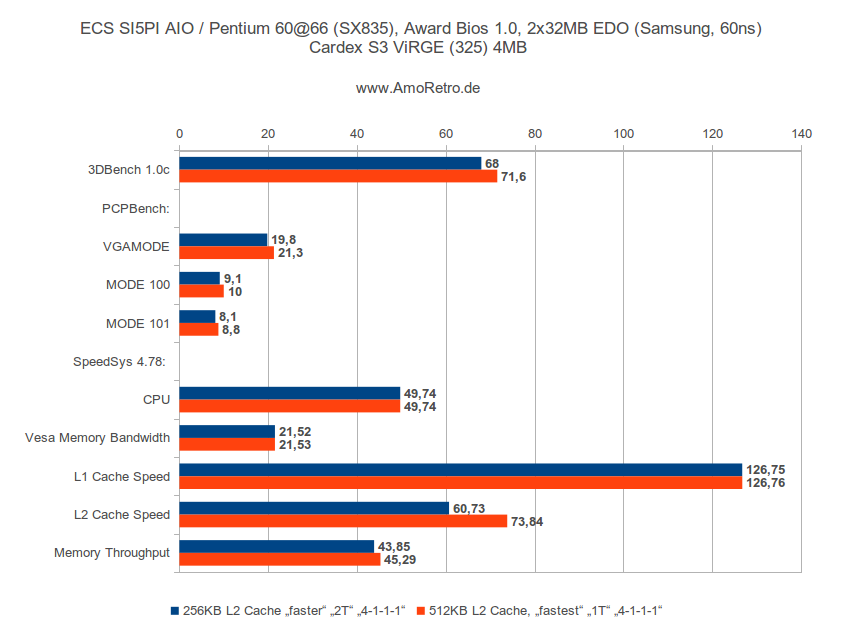First post, by FGB

I recently got my hands on a really nice Socket 4 motherboard from 1994, by far the nicest which has come along my way. I totally fell in love with it. Let me tell you why...
It's the Elitegroup SI5PI AIO with the triple-chip SiS chipset 501 502 and 503. In contrast to the vast majority of other Socket 4 boards with their quite rudimentary set of BIOS options you can tweak nearly everything (including cache timings, dram timings, clock dividers) here. The Award BIOS is also not affected by the infamous variation of the Y2K bug which causes the year to either fall back to 1912 or go to 2094 in the future. The date is stored on a changeable RTC Module from Benchmarq.
The mobo comes with the buggy CMD 540B PCI-EIDE controller, but we all know there are effective workarounds, you can also disable the CMD 32-bit transfer mode complete in the BIOS, if you want.
The PCI-Performance is also very good, taking into account that the board is such an early make of a PCI-Bus based board. Talking in numbers a S3 Virge (325) with 4MB has a Vesa Memory bandwidth of 22,5MB/s, a TsengLabs ET6000 has a bandwidth of 48MB/s. These values are very very fast and represent the hardwarelimit of the cards. So the PCI-Bus is no bottleneck here.

One of the most interesting parts of the motherboard is the L2 cache subsystem. In opposite to almost all the other Socket 4 boards the ECS has no soldered sram-modules but a field of sockets that can handle 4, 8 or even 16 modules for up to 1MB L2 cache. That is quite unique and makes the board capable of cache bank interleaving which gives the subsystem a very nice performance boost. And if you put 512KB cache into its place the whole maximum? amount of 128MB system memory is cached.
I ran various tests including 3DBench, PCPBench and SpeedSys and must say that the system really flies. I think the values confirm that the system is just darn fast for just 66MHz core clock:

The other very very interesting part of the board is the built in MX8315PC clock generator IC that is responsible for the host clock. The board has three jumpers for the bus clock and you can programm either 60MHz or 66MHz depending on your CPU (but every 60MHz Pentium should handle the 66MHz). But there are other possible (undocumented) settings. You can also jumper the board to 20mhz, 33mhz, 40mhz, 50mhz! These settings work rock stable and in combination with cache/on/off settings in the BIOS you are able to go down to very low speeds, to the sweetspot of speed sensitive games like e.g. Wing Commander.
I think this board is the ultimate 486 replacement. Put it together with a nice highly compatible ViRGE or an ultra fast (under DOS 😉 ) Riva128 or ET6000 card and a Gravis Ultrasound and a nice and clear General Midi / SoundBlaster / Roland solution and you have a stunning good rig for many years of computer gaming history:
On the one hand it has the performance of a fast DX4 or even 5x86 that allows one to play all the VGA games that require much cpu speed to run smoothly. Together with the strong FPU and the potent PCI-Subsystem you may also be able to run the very early (!) SVGA or more FPU demanding games. On the other hand you can slow this machine down to the stoneage. With 20MHz and no cache activated it is as slow as a 286. And you can hardware adjust other speeds and combine them with cache options so all the old games run without a slowdown program which may refuse to work with game A or B.
I hope you like this board as much as I do. Please tell me what you think about this solution instead of the more common high end 486 system?
German readers may be interested to read something in German. Please visit my retro-computing collection / blog:
http://www.amoretro.de/2012/03/si5pi-aio-rev- … otherboard.html
Fabian
www.AmoRetro.de Visit my huge hardware gallery with many historic items from 16MHz 286 to 1000MHz Slot A. Includes more than 80 soundcards and a growing Wavetable Recording section with more than 300 recordings.